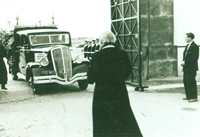
 |
Archpriest Mitrofan Znosko in front of the hearse with the body of AI Rusin at the gates of Ben M�sik Cemetery, 1956 |
|
|
Dormition Church in Casablanca |
A few days ago, an interview with the current rector of the Patriarchal church in Rabat, Fr Dimitry Orekhov, appeared on the website of Sretensky Monastery in Moscow. In the interview, Fr Dimitry said the following: �The parish had to endure a difficult trial following the end of World War II. At a parish meeting of 1952, the decision was made to switch to the jurisdiction of the Moscow Patriarchate. The so-called displaced persons who arrived in Morocco, under the influence of anti-Soviet propaganda, decided to distinguish themselves in the church sense and built their own church in Casablanca. The division continued until March 1956, when the independence of Morocco was proclaimed, and these people left the country with their pastor, the future Bishop Mitrofan (Znosko-Borovsky).��
Since this distorted version of events might be a consequence of memory loss or ignorance, I would like to clarify a few things.�
First, the division in the Rabat parish began in 1944-45, two to three years before the arrival of the displaced persons (DP�s) in Morocco. In 1946, Fr Varsonofy (Tolstukhin), the rector of the Church of the Resurrection in Rabat, under the influence of parishioners patriotically inclined to the Soviet Union, decided to leave the Russian Orthodox Church Abroad and join the Moscow Patriarchate. Many Russians, most prominently representatives of the White emigration, refused to follow him because they believed that the Mother Church administered by the Moscow Patriarchate was enslaved. In December of 1947, 300 people from the DP camps joined this core group, but they did not participate in the�parish meetings�that decided the fate of the parish in 1948. Archpriest Mitrofan Znosko arrived in Morocco only on September 2, 1948.�
Second, the part of the community that decided to remain under the Church Abroad was headed, not by displaced persons, but by Aleksandr Ivanovich Rusin. Admiral Rusin was the last full admiral of the Russian Imperial Fleet, having been appointed by Tsar Nicholas II. Rusin refused to support the request of the top military leadership that Nicholas II abdicate the throne. Having shown constancy in his monarchical convictions, Rusin opposed the February Revolution and retired on June 1, 1917. One cannot realistically claim that the anti-Soviet convictions of Admiral Rusin, the head of the community remaining under the Church Abroad, were the result of some kind of �anti-Soviet� propaganda. Other representatives of the White emigration that are mentioned on the website of the Patriarchal church in Rabat, Princess VV Urusova and AA Podchertkov, similarly remained under the Church Abroad.�
Third, it is self-evident that the DP�s did not need any �anti-Soviet propaganda� either. The Soviets propagandized on their own behalf: the Cheka (Extraordinary Commission or secret police), the Red Terror, the sacking and destruction of churches, forced collectivization, de-kulakization (the attack on so-called �rich peasants�), famine, the purges of the 1930�s, the betrayal of their own prisoners-of-war during �The Great Fatherland War,� and so forth. One hardly need be surprised that the Russian migrants, having found themselves abroad, refused to subordinate themselves to the Soviet state even indirectly.�
Fourth, far from all parishioners of the Church Abroad left Morocco. AI Rusin passed away in Casablanca on November 17, 1956. Princess VV Urusova died earlier, on February 27, 1953. Many others passed away in Morocco, having remained members of the Church Abroad and the Orthodox community in Casablanca. Hundreds of others who left Morocco, mostly former displaced persons, ended up scattered across all corners of the globe, and they carried with them their Orthodox faith and love for �Historical Russia.� Fr Mitrofan Znosko left Morocco, not in 1956 as is written in the interview, but at the end of May 1959. In the late 1950�s, Fr Mitrofan built the Dormition Church in Casablanca. After Fr Mitrofan, Fr Grigory Barannikov was the rector, and after Fr Grigory�s death other priests served the needs of the community.
There is a need to make sense of the history of the Russian people and of the Russian Church in the twentieth century, but it has to be based on accurate evidence; and accuracy is a goal for which we all should strive. �
Nicholas Ganson
Boston, USA
Sources
�Beseda s nastoiatelem khrama Voskreseniia Khristova v g. Rabate (Marokko) sviashchennikom Dimitriem Orekhovym,� [Conversation with the Rector of the Church of the Resurrection of Christ in Rabat, Morocco, Priest Dimitri Orekhov] http://www.pravoslavie.ru/guest/41745.htm#_ftn2.
Znosko-Borovskii, ep. Mitrofan. Khronika odnoi zhizni [Chronicle of a Life]. Moscow: Izdatel�stvo Sviato-Vladimirskogo Bratstva, 2006.
Lobystyn, V.V., ed. Martirolog russkoi voenno-morskoi emigratsii [Martyrology of the Russian Naval Emigration]. Moscow: Feodosiia, 2001.
�O zakhoroneniiakh sootechestvennikov na khristianskikh kladbishchakh g. Kasablanki, Marokko (spravka)� [On the Burial of Compatriots in Christian Cemeteries of Casablanca, Morocco, (Background)], http://orthodox-rabat.ru/art_11212_100.html.
Spiridovich, General AI Velikaia voina i Fevral�skaia revoliutsiia 1914-1917 g.g. [The Great War and the February Revolution 1914-1917], New York: Vseslavianskoe Izdatel�stvo, 1962.
|